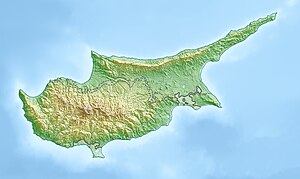Xylofagou
Xylofagou Greek: Ξυλοφάγου | |
|---|---|
 Agios Georgios church | |
| Coordinates: 34°58′30″N 33°51′6″E / 34.97500°N 33.85167°E | |
| Country | |
| District | Larnaca District |
| Population (2011)[1] | |
• Total | 6,231 |
| Time zone | UTC+2 (EET) |
| • Summer (DST) | UTC+3 (EEST) |
| Website | xylophagou |
Xylofagou (Greek: Ξυλοφάγου; locally [ksiloˈfau]) is a village in the Larnaca District of Cyprus, situated close to the A3 motorway between Paralimni and the British military base Dhekelia.
Overview
Xylofagou's name roughly translates to "wood eaters". It lies on the northern flank of a hill,[2] on the edge of a group of several similar villages collectively known as the Kokkinochoria (Greek: Κοκκινοχώρια) which translates to "red villages" due to their abundance of nutrient-dense red soil in which vegetables—especially the extremely popular potatoes that are eaten island-wide—are grown.[3]
Xylofagou is the site of the oldest known dwarf elephant fossils in Cyprus, assigned to the species Palaeoloxodon xylophagou and dating to around 200,000 years ago.[4] It is also home to a medieval Venetian watchtower.[5][6] Near Xylofagou is the Cave of the 40 Martyrs, where Christian soldiers sacrificed their lives in the 16th century to evade capture by the Ottomans.[7]
In 2021, to commemorate the role played by locally grown potatoes in the community's growth, a 16-foot-tall fibreglass potato statue nicknamed the "Big Potato" was erected in the village. It proved controversial, with some viral videos mocking its phallic shape.[8] Statue designer George Tasou said of the mockery, "I'm not bothered because it's brought publicity to our village, and I'm hoping it will promote the Cyprus potato around the world."[9]
References
- ^ "C1. POPULATION ENUMERATED BY SEX, AGE, DISTRICT, MUNICIPALITY/COMMUNITY AND QUARTER (1.10.2011)", Population - Place of Residence, 2011, Statistical Service of the Republic of Cyprus, 2014-04-17, archived from the original on 2014-04-20, retrieved 2014-04-20
- ^ Bekker-Nielsen, Tonnes (2004). The Roads of Ancient Cyprus. Museum Tusculanum Press. p. 189. ISBN 978-87-7289-956-5. Retrieved 16 March 2012.
- ^ "Kokkinochoria (Red Villages)". www.cyprusalive.com.
- ^ Athanassiou, Athanassios; Herridge, Victoria; Reese, David S.; Iliopoulos, George; Roussiakis, Socrates; Mitsopoulou, Vassiliki; Tsiolakis, Efthymios; Theodorou, George (August 2015). "Cranial evidence for the presence of a second endemic elephant species on Cyprus". Quaternary International. 379: 47–57. Bibcode:2015QuInt.379...47A. doi:10.1016/j.quaint.2015.05.065.
- ^ "The Venetian Watchtowers…". www.angloinfo.com. 20 March 2017. Retrieved 23 April 2018.
- ^ "Venetian Watchtowers Route (West Larnaka Region)". Larnaka Tourism Board. Retrieved 23 April 2018.
- ^ Bryant, Sue (27 January 2009). Frommer's Cyprus With Your Family: From the Best Family Beaches to Mountain Villages. John Wiley & Sons. p. 182. ISBN 978-0-470-72318-0. Retrieved 16 March 2012.
- ^ Castrodale, Jelisa (18 October 2021). "A Village in Cyprus Is Now Home to This 16-Foot-Tall Potato Statue". Food & Wine. Retrieved 2021-10-24.
- ^ Pitta, Antigoni (15 October 2021). "'Viral' Big Potato garners attention at home and abroad". Cyprus Mail. Retrieved 2021-10-24.


